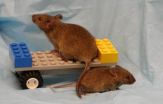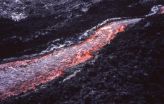(Press-News.org) Staying clear of diseases requires that the proteins in our cells cooperate with one another. But, it has been a well-guarded secret how tens of thousands of different proteins find the correct dancing partners as they degrade and build up the human body, brain and nervous system. A recent breakthrough at the University of Copenhagen's Department of Chemistry has busted down the door and provided a look at the once obscure behaviour on the protein dance floor.
Professor emeritus Jens Jørgen Led of the University of Copenhagen's Department of Chemistry and his colleagues have just published a method that helps reveal the secret dance of proteins in their article, "Specific and nonspecific interactions in ultra-weak protein-protein associations revealed by solvent paramagnetic relaxation enhancement", in the latest edition of the pre-eminent Journal of the American Chemical Society.
Until now, it has been impossible to record how proteins actually find one another in living organisms. This posed a problem because a great many biological processes begin when two proteins meet and initiate a reaction. And when things go wrong, they can go extremely wrong. From diabetes to cystic fibrosis and Parkinson's, to severe forms of dementia such as Alzheimer's – many illnesses are linked to mis-folding of the proteins, or the proteins clustering together - a process known as protein aggregation.
Jens Jørgen Led is understandably proud of his discovery. "Anyone involved in pharmaceutical development or understanding disease can apply this method. In fact, I think this is the best research that I have ever taken part in," says Jens Jørgen Led.
When a protein such as a growth hormone must find its interaction partner (its so-called receptor) there are tens of thousands of protein partners to choose from. Therefore, proteins must be equipped with a mechanism allowing them to rapidly scan an enormous number of potential interaction partners. This mechanism, termed 'ultra-weak interaction', is where proteins influence one another through electrostatic forces. It can be compared to a dancer moving along a wall, asking girls for a dance. He begins with a bow, and only if the girl nods, he takes her hand and they venture onto the dance floor.
Ultra-weak interactions are so weak that it has so far been impossible to calculate them using mathematical tools, let alone investigate them by physical measurements. But Led and his group have developed a method that makes it possible to observe the ultra-weak interactions using NMR spectroscopy. A spectrometer makes it possible to investigate molecular architecture by exposing molecules to a magnetic field. Led exploited the fact that one can observe a protein molecule's reaction in a magnetic field by deploying a paramagnetic substance called Gadodiamide. The substance is ideal for the task because it doesn't initiate chemical reactions with proteins, and therefore has no influence over protein structure. Furthermore, removing it is easy after measurement.
But changes in the protein NMR spectra are small and weak, so finding out whether the trick worked wasn't straightforward. "At first, we didn't know what we were looking at. It appeared to us as uncertainty in the data, and it was extremely time-consuming to unravel the system. I wouldn't have had the time to do this if I wasn't retired," says Jens Jørgen Led.
The new method makes it possible to see exactly how proteins bow and curtsey to one another during their dance floor courtship. This knowledge can be used in the production of proteins in an industrial setting, in the research of disease pathways and when developing new protein-based pharmaceuticals.
"It was already acknowledged that proteins found one another via ultra-weak interactions, but no one knew how to measure them. Now we can," states Led.
Jens Jørgen Led hopes that other researchers will take his discovery, incorporate it into their own work and develop the know-how so it can be used in living systems as well.
INFORMATION:
Protein courtship revealed through chemist's lens
2014-09-15
ELSE PRESS RELEASES FROM THIS DATE:
Largest ever study of awareness during general anaesthesia identifies risk factors & consequences
2014-09-15
Accidental awareness is one of the most feared complications of general anaesthesia for both patients and anaesthetists. Patients report this failure of general anaesthesia in approximately 1 in every 19,000 cases, according to a report published in Anaesthesia. Known as accidental awareness during general anaesthesia (AAGA), it occurs when general anaesthesia is intended but the patient remains conscious. This incidence of patient reports of awareness is much lower than previous estimates of awareness, which were as high as 1 in 600.
The findings come from the largest ...
Zebrafish genes linked to human respiratory diseases
2014-09-15
Singapore, 15 September 2014—A small freshwater fish found in many tropical aquariums may hold the key to unlocking one of the leading causes of respiratory diseases in humans.
Scientists from A*STAR's Institute of Molecular and Cell Biology (IMCB) have identified hundreds of novel genes in the zebrafish that could be functionally identical to the human genes required for forming motile cilia, hair-like structures on the surface of airway cells. These are required for removing dust and pathogens from the human airway. The study showed that the loss of these genes is ...
Poor diet may increase risk of Parkinson's disease
2014-09-15
Obesity caused by a high-fat diet may increase the risk of developing Parkinson's disease, new research in mice suggests. Upon aging, a high-fat diet significantly accelerated the onset of neurological symptoms in mice that were genetically predisposed to develop Parkinson's disease.
The Journal of Neurochemistry findings suggest that in addition to having negative effects on glucose and insulin regulation in the body, an unhealthy diet may also cause damage in the brain. More research is needed to uncover the molecular and cellular mechanisms involved.
INFORMATION:
...
Tigers, pandas and people a recipe for conservation insight
2014-09-15
VIDEO:
Neil Carter and Vanessa Hull talk about what they've learned from the animals -- and people -- they study.
Click here for more information.
The first big revelation in conservation sciences was that studying the people on the scene as well as nature conservation was crucial. Now, as this science matures, researchers are showing that it's useful to compare apples and oranges.
Or, more accurately, tigers and pandas.
In this week's journal Ecology & Society, Michigan ...
Airborne particles beyond traffic fumes may affect asthma risk
2014-09-15
Researchers in Sydney and Newcastle, Australia have found that elements of dust, particularly those coarse particles that contain iron traces, stimulate the production of inflammatory molecules in cells from the airways of mice and healthy human volunteers. Surprisingly, traffic fume pollutants did not cause these changes. The findings are featured in a new Respirology study.
"These effects are likely to contribute to the development of asthma in childhood, as well as to worsening of asthma when pollution levels are high." said Dr. Rakesh Kumar, lead author of the study. ...
Cellular protein may be key to longevity
2014-09-15
Researchers have found that levels of a regulatory protein called ATF4, and the corresponding levels of the molecules whose expression it controls, are elevated in the livers of mice exposed to multiple interventions known increase longevity.
Elevation of ATF4, at least in the liver, seems to be a shared feature of diets, drugs, genes, and developmental alterations that extend maximum lifespan.
"Pathways that appear to change in the same way in many different kinds of slow-aging mice may provide helpful hints towards the design of drugs that keep people healthy longer ...
A thin line lies between fantasy and reality in people with psychopathic traits
2014-09-15
New research indicates that people with psychopathic traits have a preference for nonromantic sexual fantasies with anonymous and uncommitted partners. The study's investigators noted that psychopathic sexual behavior is likely due to a preference for sexual activity outside a loving, committed relationship rather than only an inability to form such relationships.
Individuals with deviant sexual preferences and normal levels of empathy, kindness, and self-control have many strategies for satisfying their needs, including negotiation, compromise, and restraint; however, ...
Run, cheetah, run
2014-09-15
CAMBRIDGE, MA -- Speed and agility are hallmarks of the cheetah: The big predator is the fastest land animal on Earth, able to accelerate to 60 mph in just a few seconds. As it ramps up to top speed, a cheetah pumps its legs in tandem, bounding until it reaches a full gallop.
Now MIT researchers have developed an algorithm for bounding that they've successfully implemented in a robotic cheetah — a sleek, four-legged assemblage of gears, batteries, and electric motors that weighs about as much as its feline counterpart. The team recently took the robot for a test run on ...
How a change in slope affects lava flows
2014-09-15
As soon as lava flows from a volcano, exposure to air and wind causes it to start to cool and harden. Rather than hardening evenly, the energy exchange tends to take place primarily at the surface. The cooling causes a crust to form on the outer edges of the lava flow, insulating the molten lava within. This hardened lava shell allows a lava flow to travel much further than it would otherwise, while cracks in the lava's crust can cause it to draw up short.
When there is a break in the terrain—a sharp change in slope, a valley, or a rock wall, for example—the smooth lava ...
Predicting prostate cancer: Pitt-developed test identifies new methods for treatment
2014-09-15
PITTSBURGH, Sept. 15, 2014 – A genetic discovery out of the University of Pittsburgh School of Medicine is leading to a highly accurate test for aggressive prostate cancer and identifies new avenues for treatment.
The analysis, published today in the American Journal of Pathology, found that prostate cancer patients who carry certain genetic mutations have a 91 percent chance of their cancer recurring. This research was funded by the National Institutes of Health (NIH), American Cancer Society and University of Pittsburgh Cancer Institute (UPCI).
"Being able to say, ...



